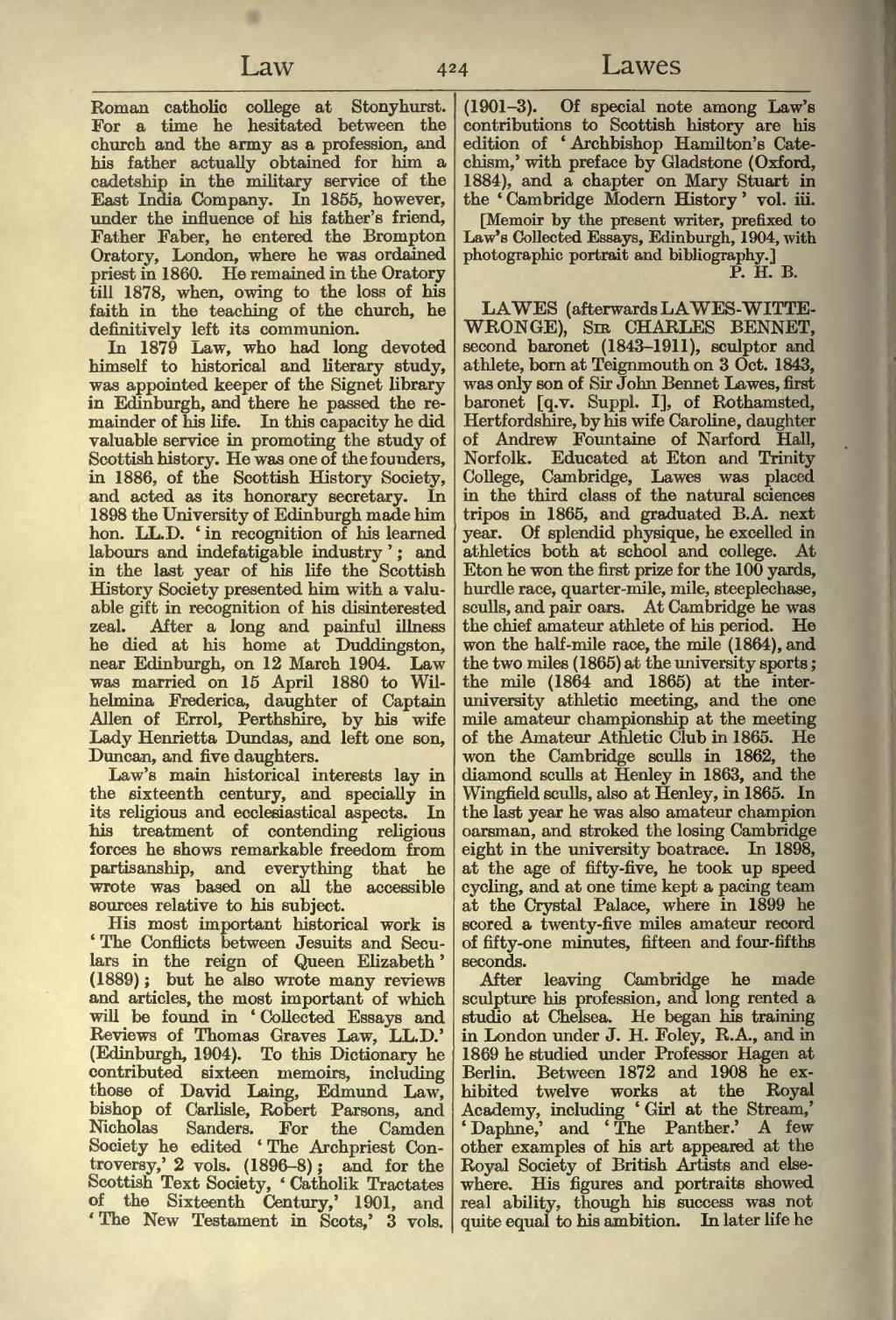Roman catholic college at Stonyhurst. For a time he hesitated between the church and the army as a profession, and his father actually obtained for him a cadetship in the military service of the East India Company. In 1855, however, under the influence of his father's friend, Father Faber, he entered the Brompton Oratory, London, where he was ordained priest in 1860. He remained in the Oratory till 1878, when, owing to the loss of his faith in the teaching of the church, he definitively left its communion.
In 1879 Law, who had long devoted himself to historical and literary study, was appointed keeper of the Signet library in Edinburgh, and there he passed the remainder of his life. In this capacity he did valuable service in promoting the study of Scottish history. He was one of the founders, in 1886, of the Scottish History Society, and acted as its honorary secretary. In 1898 the University of Edinburgh made him hon. LL.D. 'in recognition of his learned labours and indefatigable industry'; and in the last year of his life the Scottish History Society presented him with a valuable gift in recognition of his disinterested zeal. After a long and painful illness he died at his home at Duddingston, near Edinburgh, on 12 March 1904. Law was married on 15 April 1880 to Wilhelmina Frederica, daughter of Captain Allen of Errol, Perthshire, by his wife Lady Henrietta Dundas, and left one son, Duncan, and five daughters.
Law's main historical interests lay in the sixteenth century, and specially in its religious and ecclesiastical aspects. In his treatment of contending religious forces he shows remarkable freedom from partisanship, and everything that he wrote was based on all the accessible sources relative to his subject.
His most important historical work is 'The Conflicts between Jesuits and Seculars in the reign of Queen Elizabeth' (1889); but he also wrote many reviews and articles, the most important of which will be found in 'Collected Essays and Reviews of Thomas Graves Law, LL.D.' (Edinburgh, 1904). To this Dictionary he contributed sixteen memoirs, including those of David Laing, Edmund Law, bishop of Carlisle, Robert Parsons, and Nicholas Sanders. For the Camden Society he edited 'The Archpriest Controversy,' 2 vols. (1896-8); and for the Scottish Text Society, 'Catholik Tractates of the Sixteenth Century,' 1901, and 'The New Testament in Scots,' 3 vols. (1901-3). Of special note among Law's contributions to Scottish history are his edition of ' Archbishop Hamilton's Catechism,' with preface by Gladstone (Oxford, 1884), and a chapter on Mary Stuart in the 'Cambridge Modern History' vol. iii.
[Memoir by the present writer, prefixed to Law's Collected Essays, Edinburgh, 1904, with photographic portrait and bibliography.]
LAWES (afterwards LAWES-WITTE-WRONGE), Sir CHARLES BENNET, second baronet (1843–1911), sculptor and athlete, born at Teignmouth on 3 Oct. 1843, was only son of Sir John Bennet Lawes, first baronet [q. v. Suppl. I], of Rothamsted, Hertfordshire, by his wife Caroline, daughter of Andrew Fountaine of Narford Hall, Norfolk. Educated at Eton and Trinity College, Cambridge, Lawes was placed in the third class of the natural sciences tripos in 1865, and graduated B.A. next year. Of splendid physique, he excelled in athletics both at school and college. At Eton he won the first prize for the 10 yards, hurdle race, quarter-mile, mile, steeplechase, sculls, and pair oars. At Cambridge he was the chief amateur athlete of his period. He won the half-mile race, the mile (1864), and the two miles (1865) at the university sports; the mile (1864 and 1865) at the inter-university athletic meeting, and the one mile amateur championship at the meeting of the Amateur Athletic Club in 1865. He won the Cambridge sculls in 1862, the diamond sculls at Henley in 1863, and the Wingfield sculls, also at Henley, in 1865. In the last year he was also amateur champion oarsman, and stroked the losing Cambridge eight in the university boatrace. In 1898, at the age of fifty-five, he took up speed cycling, and at one time kept a pacing team at the Crystal Palace, where in 1899 he scored a twenty-five miles amateur record of fifty-one minutes, fifteen and four-fifths.
After leaving Cambridge he made sculpture his profession, and long rented a studio at Chelsea. He began his training in London under J. H. Foley, R.A., and in 1869 he studied under Professor Hagen at Berlin. Between 1872 and 1908 he exhibited twelve works at the Royal Academy, including 'Girl at the Stream,' 'Daphne,' and 'The Panther.' A few other examples of his art appeared at the Royal Society of British Artists and elsewhere. His figures and portraits showed real ability, though his success was not quite equal to his ambition. In later life he
